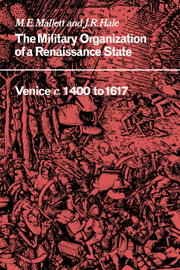Book contents
- Frontmatter
- Contents
- List of illustrations
- Acknowledgements
- References and abbreviations
- Map 1 The Terraferma in the fifteenth and sixteenth centuries
- Map 2 The empire da Mar
- PART I c. 1400 to 1508
- PART II 1509–1617
- Conclusion: the European context 1525–1617
- Appendix Infantry wages in the sixteenth century
- Select bibliography
- Index
Appendix - Infantry wages in the sixteenth century
Published online by Cambridge University Press: 22 October 2009
- Frontmatter
- Contents
- List of illustrations
- Acknowledgements
- References and abbreviations
- Map 1 The Terraferma in the fifteenth and sixteenth centuries
- Map 2 The empire da Mar
- PART I c. 1400 to 1508
- PART II 1509–1617
- Conclusion: the European context 1525–1617
- Appendix Infantry wages in the sixteenth century
- Select bibliography
- Index
Summary
Among military facts, the most important before the introduction of sophisticated industrialized technology was the wage of the ranker infantryman. It determined, more than any other figure, the overall cost of defence and war; it was crucial to the quantity and quality of recruitment. Mulcted of legitimate stoppages and illegal withholdings, it conditioned the life experience of the soldier. Given the nature of the sources it is easier to assess the official wage than the sum that actually went into an individual's pocket on pay day.
The basic unit in the annual wage was the paga or ‘pay’. In peacetime this was given out every 45 days, or eight times a year, up to 1589, when ten pays became the norm on the Terraferma. Overseas, where the cost of living was higher, ten pays had been given as a temporary measure to attract new drafts in 1568 and early 1570. From November 1573 ten pays became the norm da Mar; this was temporarily increased to twelve in periods of dearth and in 1592 monthly pay was made permanent in Dalmatia. In 1601 this rate was extended to Corfu and Crete. On the Terraferma twelve pays became standard, garrison by garrison, in 1600–1 though this was not confirmed as the new norm until 1615.
From 1509 the standard wartime rate, both for the permanent garrison force and for new recruits, was ten pays a year at home and overseas. With hostilities between 1509 and 1529 restricted to the mainland, troops da Mar were paid only eight times a year.
- Type
- Chapter
- Information
- The Military Organisation of a Renaissance StateVenice c.1400 to 1617, pp. 494 - 501Publisher: Cambridge University PressPrint publication year: 1984



